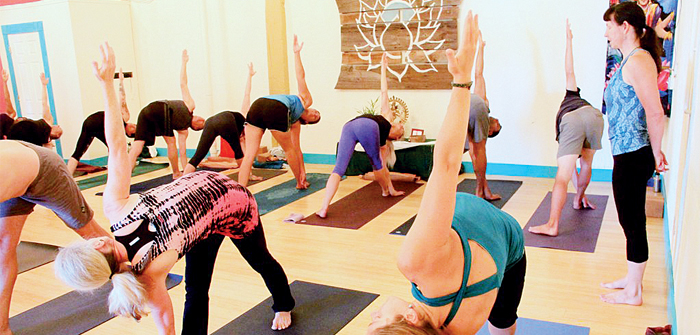In the early 90’s Bend only had a few yoga teachers and even fewer yoga studios. Southwell recalls, “Yoga and eastern teachings may have been delayed in the Central Oregon area and slow to be popularized due to the controversial nature of the Osho commune near Antelope: the Rashneesh Puram.”
A few years later, The Athletic Club of Bend, Shanti Yoga Studio, Juniper Fitness and several private teachers enriched the yoga community. “Now,” Southwell reflects, “the ratio of studios, teachers and students of yoga is uniquely high compared to our population as a city and we even have a ‘yoga festival’ called Yu Yoga every year that unites teachers and students across Bend.”
Southwell tells me she is accredited in Ashtanga Vinyasa by the guru Sri K. Pattabhi Jois in the Mysore tradition, mentioning several times that knowing the lineage behind Ashtanga has been integral as a participant and practitioner. She explains, “Vinyasa (meaning movements linked with breath) also includes ways of living and conduct as well as meditation and spiritual devotion” and that “there is a reason the words “meditation” and “medicine” have the same prefix, which means to look at, examine or find the middle point.”
It was the mental aspect which first drew Southwell to yoga. During her collegiate and national level ski racing career in Boulder, Colorado she, “felt drawn to learn about the mental edge that meditation and yoga could bring.” After attending her first yoga class she remembers, “noticing the open, altered state of mind that the practice had created. It was both profoundly peaceful and almost ‘sparkling’ crisp in terms of the perception I had around me. I was sold, and practiced in classes and on my own from books from then on.”
Today, with more than 25 years of experience, 15 years as an instructor, six visits to India to study on sight in Mysore, mentorships, several teacher trainings and directing several schools and studios, Southwell points to her personal daily practice and contact with students over the years as the main source of wisdom and ‘education’ she has gained.
Southwell feels yoga brings many health benefits to herself and her students. “Besides its numerous mental and physical benefits,” she says “one of the main aspects of yoga practice is developing an awareness of one’s self. In this way we can monitor and feel the changes in our body and mind and how they affect us.” One example Southwell uses is healing an injury. “[ In this process] we may uncover patterns of posture that are not serving us or in watching the mind in daily practice we may realize how the dialogue in our heads may be contributing to anxiety, distraction and unhealthy patterns of self-talk.”
Specifically, Southwell notes the following health benefits are attributed to a regular yoga practice: spiritual awakening, mental clarity and relaxation, enhanced awareness, improvements in strength, flexibility, balance, increased circulation, breathing capacity, improvements in posture and muscle/joint/bone systems, hormonal balance, harmony in relationships, decrease of stress and distraction in life, sense of humor, and according to the ancient yogic texts, yoga asans (postures) and pranayama (breathing practices) can free one from disease and fear of death itself.
Due to health benefits Southwell has felt from yoga, she expresses a complete change and enhancement. “Because of the lifestyle that naturally evolves from the practice of yoga I feel younger, more able to deal with life’s stresses and more available to be present to the people and situations around me. I naturally want to eat better, and keep healthy life choices, not as a discipline but as an effect of the yoga study.”
When asked why she thought Eastern and Western philosophies diverged so much when it comes to medicine, Southwell commented, “Eastern philosophy, including the yogic practices and their holistic medical system called auerveda, address at the whole person, and recognize diet, lifestyle and mental/spiritual health as major factors in preventing disease. Many enter [the yoga practice]on a purely ‘physical fitness’ level.” Southwell cautions against this and supports “a meditation practice of tuning into and respecting/nurturing ourselves exactly where we are in the moment in body and mind. It is from there that harmony and health can progress, not in striving or treating symptoms of ill health or going for the perfect physique or fitness.” She urges that continued study in yoga and a daily commitment of “coming to the mat as a lifestyle of preventative health” is the medicine that the practitioner or yogi will receive.
For those interested in the many health benefits accompanying yoga practice, Bend Ashtanga Yoga School, located at The Yoga Lab near the Old Mill, meets early mornings everyday of the week except Saturdays. Aspiring students can start at entry level in the program and learn step by step the tradition sequences of Ashtanga Yoga. All levels are welcome and one can see all ages, body types and levels of yoga practice in the same room.
After class, when I ask Southwell why I have such a difficult time mirroring her, she explained, “Whatever the question is, the answer is more yoga.” And when I told her how great I felt post lesson, she replied “Yoga is a form of mind and body training, a lifestyle. We use the physical postures, breathing and philosophic practices in order to create a healthy/ alive body, calm mind and a perspective towards life that is respectful and mindful.” I couldn’t help but wonder, what could be better medicine than that?





